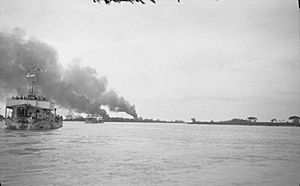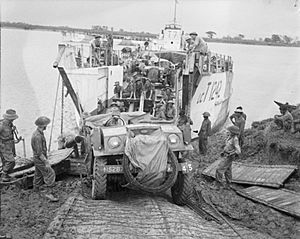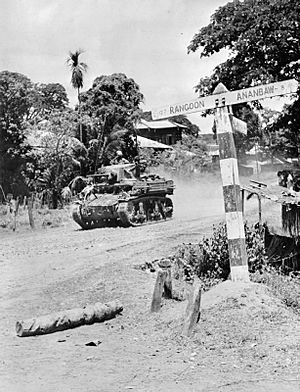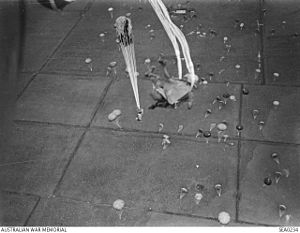Operation Dracula facts for kids
Quick facts for kids Operation Dracula |
|||||||
|---|---|---|---|---|---|---|---|
| Part of the Burma Campaign | |||||||
 Landing craft carry troops up the Rangoon River |
|||||||
|
|||||||
| Belligerents | |||||||
|
Naval Support: |
|||||||
| Commanders and leaders | |||||||
| Strength | |||||||
| 1 infantry division 1 airborne battalion |
small parties | ||||||
| Casualties and losses | |||||||
| 24 (from friendly fire) | 30 | ||||||
Operation Dracula was a major attack during World War II. It involved soldiers parachuting from planes and landing from ships. British and Anglo-Indian forces carried out this attack on Rangoon, a key city in Burma. This operation was part of the larger Burma Campaign.
The idea for this attack first came up in mid-1944. At that time, the Allied forces in South East Asia Command were getting ready to take back Burma. However, the plan was put on hold because they didn't have enough landing ships and other important supplies.
In March 1945, the plan was brought back. It was super important to capture Rangoon before the monsoon rains started. The monsoon was expected in early May. Taking Rangoon would help the Allied troops in Burma get their supplies easily.
In April 1945, British Fourteenth Army units got very close to Rangoon. They were about 40 kilometers (25 miles) away. But a Japanese force held them up until May 1 in a town called Pegu. On that same day, as part of Operation Dracula, a special group of Gurkha paratroopers landed at Elephant Point. This spot was at the mouth of the Rangoon River.
After the paratroopers secured the coastal guns, special ships called minesweepers cleared the river of dangerous mines. On May 2, the Indian 26th Division started landing on both sides of the river. The monsoon rains also began that day, earlier than expected. However, the Imperial Japanese Army had already left Rangoon a few days before. So, the Indian 26th Division took over the city and its important docks without any fighting. They met up with the Fourteenth Army four days later.
Contents
Why Rangoon Was Important
Rangoon was the capital city and the biggest port in Burma. In December 1941, Japan joined World War II. They attacked the United States and the colonies of Britain and the Netherlands in the Far East.
The Japanese bombed Rangoon on December 23, 1941. People started leaving the city. By February 1942, there was a huge rush of people leaving. Indian, Anglo-Indian, and Anglo-Burmese people fled. They were afraid of both the Japanese and some local Burmese. This left the city without anyone in charge.
After taking over Thailand, the Japanese Army attacked southern Burma in March 1942. The British, Indian, and Burmese forces were not strong enough. They had to leave Rangoon. This made it impossible for Britain to defend Burma for long. There were no other good ways to get supplies overland from India. The British and Chinese forces had to leave Burma and go back to India and China.
Things stayed quiet for about a year. By 1944, the Allied forces in India had grown stronger. They also had better ways to get supplies. This meant they could plan to attack Burma again. The Japanese tried to stop them by invading India. But the Japanese lost badly at the Battle of Imphal. They also had other problems in Northern Burma. These losses made it harder for them to defend Burma the next year.
Allied Plans for Burma
In July 1944, the Allied South East Asia Command started making clear plans to take back Burma. The Battle of Imphal was still happening, but it was clear the Japanese would have to retreat with many losses.
One idea the South East Asia Command looked at was a sea attack on Rangoon. This plan was first called Plan Z. (Plan X was about taking back only northern Burma. This was done by the American-led Northern Combat Area Command. Their goal was to finish the Ledo Road linking China and India. Plan Y was for an Allied attack into Central Burma by the British Fourteenth Army.)
Plan Z, which later became Operation Dracula, had several good points. Losing Rangoon would be even worse for the Japanese in 1945 than it was for the British in 1942. Rangoon was the main port where Japanese forces in Burma got their supplies and extra soldiers. It was also very close to their other supply routes to Thailand and Malaya.
If Allied forces moved just 40 kilometers (25 miles) north or east from Rangoon to Pegu, or across the Sittang River, they would cut the Burma Railway. They would also cut several main roads. These were the only land links for the Japanese with their forces in Thailand and Malaya. If Rangoon fell, the Japanese would have to leave almost all of Burma. They would also lose much of their equipment.
However, Allied planners thought that such a big sea attack would need many resources. These included landing ships, warships to protect them, and engineering tools. They believed these would not be ready until the war in Europe was over. (At that time, the Battle of Normandy was happening, and its outcome was still uncertain.) So, Operation Dracula was put off. Instead, Plan Y, now called Operation Capital, was chosen.
Later in 1944, enough landing ships and other sea attack resources became available. They were first used in operations along the Burmese coast in the province of Arakan. Indian XV Corps, led by Lieutenant General Sir Philip Christison, captured Akyab Island on December 31, 1944. This island had an important airfield. In late January 1945, Allied troops landed on the Myebon peninsula. They caused heavy losses to retreating Japanese troops. Also on January 21, Allied troops landed easily on Cheduba Island. They also landed on Ramree Island, which was cleared of Japanese troops after a tough fight called the Battle of Ramree Island. Airfields were quickly built on these islands. This allowed the Fourteenth Army to get supplies by transport planes as they moved into Central Burma.
Dracula Is Back!
In February and March 1945, the Fourteenth Army, led by Lieutenant General William Slim, fought the Battle of Central Burma. The Japanese were badly beaten. Most of their forces were much smaller than before. They had to retreat into the Shan States. Slim told his forces to use their victory to push south. They moved along the Irrawaddy River and Sittang River valleys towards Rangoon. In April, Indian IV Corps, led by Lieutenant General Frank Messervy, moved almost 200 kilometers (124 miles) south. They were getting close to Pegu, 40 kilometers (25 miles) north of Rangoon, by the end of the month. Pegu was one of the largest towns in Southern Burma. It was only a few miles north of the roads and railways that connected Rangoon with Thailand and Malaya.
Even with these big successes, Slim was worried. Messervy and some of his commanders thought they might capture Rangoon in early May. But the Fourteenth Army's supply lines were stretched to their limit because of the fast advance. The monsoon was coming soon. The heavy rains would make many roads impossible to use. They would also make it hard to get supplies by air. It was feared that the Japanese would fight to the very end in Rangoon. They had done this in other places in the Pacific, like at Manila in the Philippines. Japanese forces defended Manila for a month. The city was left in ruins.
If Rangoon was not captured before the monsoon, Slim's forces would have a terrible supply problem. So, in late March, he asked for Operation Dracula to be brought back. It needed to happen before the monsoon began, which was expected in early May. On April 2, Admiral Louis Mountbatten, the top commander of South East Asia Command, ordered Rangoon to be captured by sea invasion no later than May 5. Before the order to bring back Dracula was given, South East Asia Command was planning to attack Phuket Island off Thailand. This was meant to be a step towards attacking Singapore. (That operation was called Operation Roger.) So, the navy and air forces needed for Dracula were already in place. Indian XV Corps HQ would control the ground forces. As a first step for Dracula, IV Corps was told to capture the airfields at Toungoo, no matter the cost. This was so planes could protect the invasion. The airfields were captured by the Indian 5th Division on April 22.
Battle for Rangoon
The main Japanese headquarters in Burma, the Burma Area Army, was in Rangoon. It was led by Lieutenant General Hyotaro Kimura. There were no Japanese fighting units based in the city. But there were many supply troops and navy personnel. There was also a large group of the Indian National Army (INA). This force was made mostly of former Indian prisoners of war. They had been captured by the Japanese in Malaya. They wanted to overthrow British rule in India. Some INA units had fought hard in the Japanese invasion of India in 1944 and in central Burma. But by early 1945, most INA soldiers felt very low in spirits. Many were sure that Japan would lose the war. They often left or surrendered easily during the Allied advance on Rangoon.
Kimura had already decided not to defend Rangoon. He planned to leave the city and retreat to Moulmein in southern Burma. His boss, Field Marshal Hisaichi Terauchi, told him to hold Rangoon until death. But Kimura thought this would just destroy his remaining forces for no good reason. Kimura's chief of staff, Lieutenant General Shinichi Tanaka, disagreed. Tanaka had ordered defenses to be built in Rangoon. Ba Maw, the Prime Minister of the Burmese government (which was only independent in name), convinced the Japanese not to turn the Shwedagon Pagoda into a gun position.
However, Tanaka flew north on April 19 to check the situation around Toungoo. While he was away, the remaining staff wrote orders for the evacuation. Kimura signed them without hesitation. When Tanaka came back on April 23, he protested, but it didn't help. Because the Army HQ's radios had already been moved to Moulmein, the Army could no longer control the overall battle for Burma from Rangoon.
Japanese Leave Rangoon
As the British and Indian troops got close to Pegu, many Japanese support troops in the Rangoon area were formed into a new group. Even some Japanese civilians who were quickly called up joined. This group was the Japanese 105th Independent Mixed Brigade. It was led by Major General Hideji Matsui. He had just been made commander of the "Rangoon Defence Force." This brigade included anti-aircraft units, airfield builders, navy units, and other odds and ends. They were sent north to defend Pegu. But they were delayed because there wasn't enough transport. Vehicles had been taken for Kimura's headquarters and other units leaving Rangoon. So, they arrived bit by bit.
Major General Matsui was also angry about the evacuation of Rangoon. He hadn't been told about it before finding that Kimura's headquarters had been quickly left on April 26. After trying without success to move Allied prisoners of war who couldn't walk, and to destroy the port, Matsui then went north to lead the defense of Pegu.
Many Japanese troops left Rangoon by sea. Nine out of eleven ships carrying a thousand soldiers were sunk by British destroyers in the Gulf of Martaban on April 30. Kimura himself left by plane. Most of Kimura's HQ and the groups of Ba Maw and Subhas Chandra Bose (commander of the Indian National Army) left by land. Matsui's troops at Pegu covered their retreat. But they were attacked several times by Allied planes. The Japanese failed to provide transport for Ba Maw's staff. Most of them had to walk to Moulmein. Ba Maw himself started his trip by car with his wife and pregnant daughter. His daughter gave birth at Kyaikto, 16 kilometers (10 miles) east of the Sittang. He was afraid he would be killed if he went to Moulmein, so he fled to Tokyo instead. Bose thought Ba Maw's flight was dishonorable. He marched on foot with his last troops. He had first arranged for trucks to move a women's unit, the Rani of Jhansi Regiment.
The only people left in Rangoon were 5,000 troops of the Indian National Army. They were led by Major General A. D. Loganathan. Bose had left them to protect the remaining Indian community from attacks by lawless Burmese. Loganathan had no plan to fight the Allied attacks. He intended to hand over his men and responsibility for the city to the British when they arrived.
Fighting at Pegu
While the Japanese were leaving, the main British and Indian troops of IV Corps were getting close to Pegu. This was the Indian 17th Division, with most of the 255th Indian Tank Brigade. Messervy's leading tanks first met resistance from Matsui's forces on April 27. Matsui had sent a group forward to defend Payagyi, a few miles north of Pegu. This group was mostly made of mixed supply troops, but also included a battalion from a Japanese independent mixed brigade. Matsui's engineers laid mines and booby-trapped obstacles to slow down the British tanks. Even more delays came from heavy rain on April 28. It turned dusty roads into mud and made streams and rivers overflow.
On April 28, the advancing IV Corps troops cut the road between Pegu and the Sittang River. This finally cut off Japanese communications between Rangoon and Moulmein. A small Japanese truck convoy that ran into the roadblock was completely destroyed.
The Indian 17th Division cleared Payagyi and nearby villages on April 29. They launched their main attack on Pegu on April 30. The Japanese held the western part of Pegu. They destroyed all the bridges across the Pegu River that separated their positions from the eastern part of the town. Water reservoirs and flooded fields stopped the Indian Division from going around the Japanese. Indian soldiers managed to cross the metal beams of two destroyed railway bridges that were still partly standing. They set up small positions on the west bank, protected by artillery and tank fire. Other Indian units met strong resistance near the main road bridge. More units made little progress. A deep ditch held up the tanks of the 9th Royal Deccan Horse.
However, on the morning of May 1, Indian patrols found that the Japanese had left. The 17th Division quickly built a bridge over the Pegu River and continued its advance. But the monsoon had already started. Within hours, the countryside was flooded. The advance slowed to a crawl. Slim immediately put all of IV Corps on half rations to help with supplies.
On April 30, Matsui had received another order from Kimura, who was now in Moulmein. The order was to leave Pegu and go back to defend Rangoon to the death. Matsui could have kept fighting in Pegu for some more days if needed. But he followed the order and pulled back. As his force moved along the open road to Hlegu, they came under attack. Matsui ordered a retreat into the hills west of Pegu.
Dracula Begins!

The British knew by April 24 that the Burma Area Army HQ had left Rangoon. This was thanks to secret messages they intercepted. But they didn't know that the Japanese were about to leave the city completely. They thought the landings would face strong resistance. Under the changed plan for Dracula, the Indian 26th Division, led by Major General Henry Chambers, would create landing spots on both sides of the Rangoon River. The British 2nd Division would then follow through these spots a few days later to launch the main attack on the city.
The Indian 26th Division and other forces sailed in six groups from Akyab and Ramree Island. They left between April 27 and April 30. Rear-Admiral Benjamin Martin, leading Force W, was in charge of moving and landing the British and Indian attack forces. The naval protection force included the 21st Aircraft Carrier Squadron, led by Commodore Geoffrey Oliver. This group had four small aircraft carriers, two cruisers, and four destroyers. The 3rd Battle Squadron, led by Vice Admiral Harold Walker, also helped. It had two battleships (HMS Queen Elizabeth and the French battleship Richelieu), two small aircraft carriers, four cruisers (one Dutch), and six destroyers. Another group of five destroyers was responsible for destroying the main Japanese evacuation ships. 224 Group of the Royal Air Force, led by Air Vice Marshal the Earl of Bandon, provided air cover from airfields around Toungoo and on Ramree Island.
Early on May 1, many planes attacked Japanese defenses south of Rangoon. These included eight squadrons of B-24 Liberator and four of B-25 Mitchells bombers. Also, two squadrons of P-51 Mustangs fighter planes from the 2nd Air Commando Group of the United States Army Air Forces (USAAF) bombed and shot at the Japanese. A small group from Force 136 and a 700-man Gurkha parachute battalion from the 50th Indian Parachute Brigade were dropped from C-47s planes. They landed at Elephant Point at the mouth of the Rangoon River in the middle of the morning. They removed some small Japanese groups, who were either left behind or forgotten. They captured or destroyed several guns that overlooked the sea routes to Rangoon. They had thirty casualties from Allied bombs that missed their targets.
Once Elephant Point was safe, minesweepers cleared a path up the river. Landing craft started coming ashore in the early morning of May 2. This was almost the last day when beach landings were possible before the heavy waves from the monsoon became too bad. An Allied Mosquito reconnaissance plane flying over Rangoon saw no sign of the Japanese in the city. It also noticed a message painted on the roof of the jail by British prisoners of war who had been released. It said, Japs gone. Extract digit – which was RAF slang for "get on with it." The prison had been taken over by Wing Commander Lionel Hudson, who was leading the former prisoners in getting ready for the British advance. Boldly, the plane's crew tried to land at Mingaladon Airfield. But they damaged their tailwheel on the bumpy runway, so they couldn't take off again. They walked to the jail, where they found 1,000 former prisoners of war. These prisoners told them that the Japanese had left. The air crew then went to the docks. They took a small boat called a sampan and sailed it down the river to meet the landing craft.
What Happened Next
The troops of the Indian 26th Division started taking over the city without any fighting on May 2. The British were welcomed with joy. People were happy because order could be brought back, and food and other help would arrive. When the Japanese and Ba Maw's officials left Rangoon, there was a lot of stealing and lawlessness for several days. The retreating Japanese had burned down the jail where Burmese prisoners were kept. They had also destroyed St. Philomena's Convent, which was used as a hospital. This killed 400 of their own men. After three years of war and hardship, the city was very dirty. Many people had fled to escape the Kempeitai (Japanese military police). Those who stayed were in rags. Armed bandits troubled the areas outside the city. Many infectious diseases were common.
Units of the 26th Division moved out along the main roads to meet up with the Fourteenth Army. On May 6, they met the leading troops of the 17th Division. These troops were pushing through floods southwards from Pegu. They met at Hlegu, 28 kilometers (17 miles) north east of Rangoon. The Fourteenth Army and other Allied forces in Burma now had a safe way to get supplies.
Matsui's Kani Force joined the remaining parts of the Japanese Twenty-Eighth Army in the Pegu Yomas mountains. In July, these forces tried to break out eastwards to join the other Japanese armies east of the Sittang. Matsui's men had slightly fewer losses in this costly operation than most of the other Japanese units involved. However, the navy personnel in Matsui's force broke out separately from the main group, several days later. This allowed Allied units to focus their attacks on them. They were almost completely wiped out, with only a few surviving.
|



